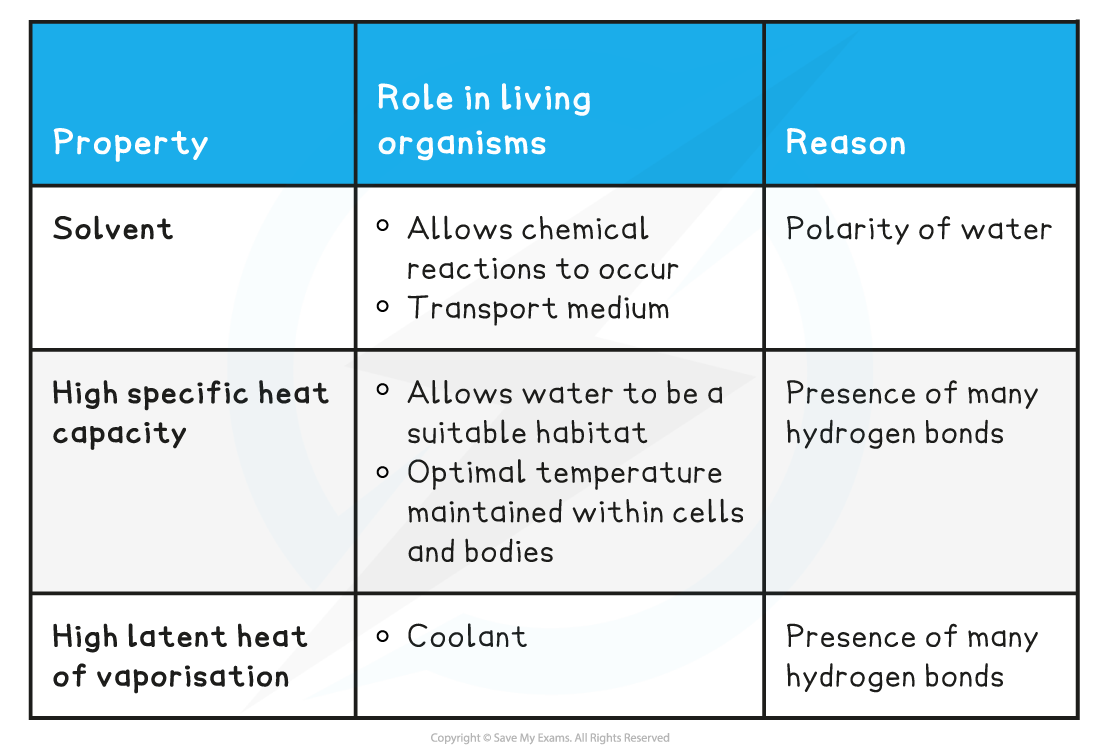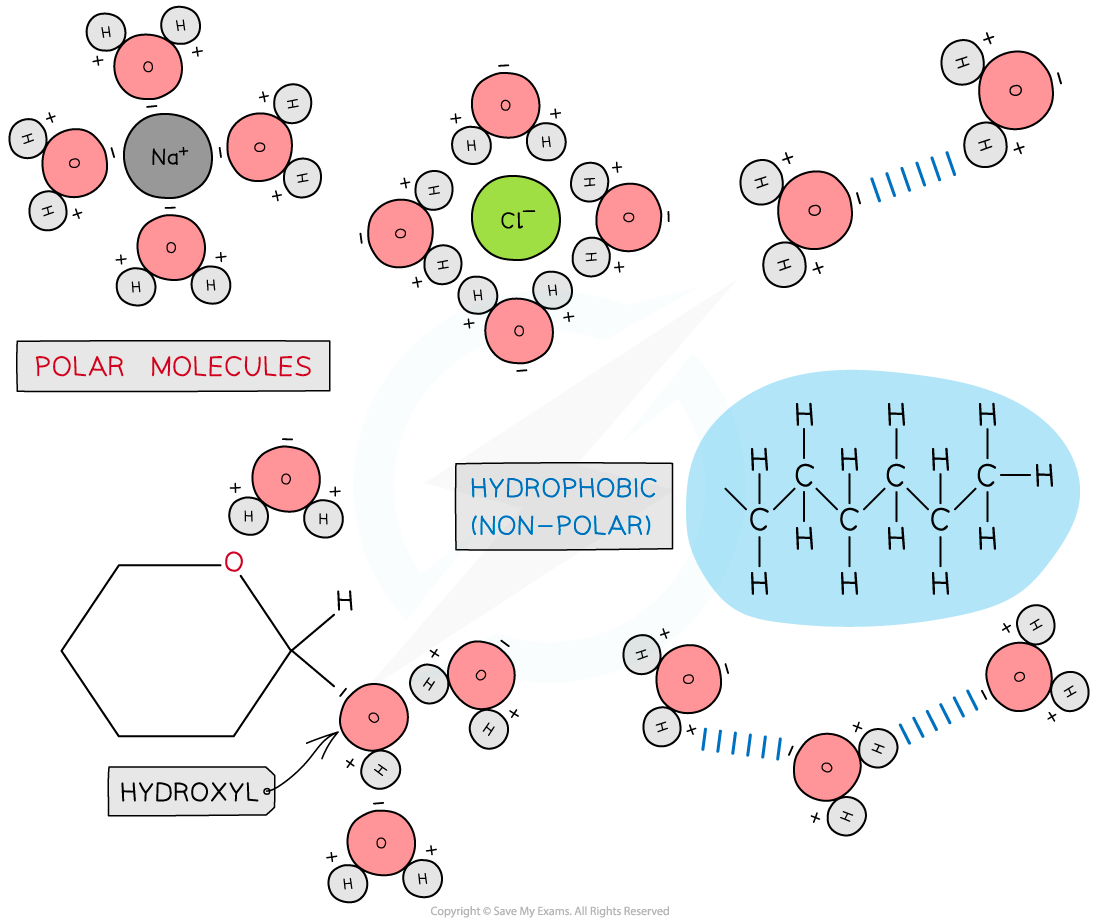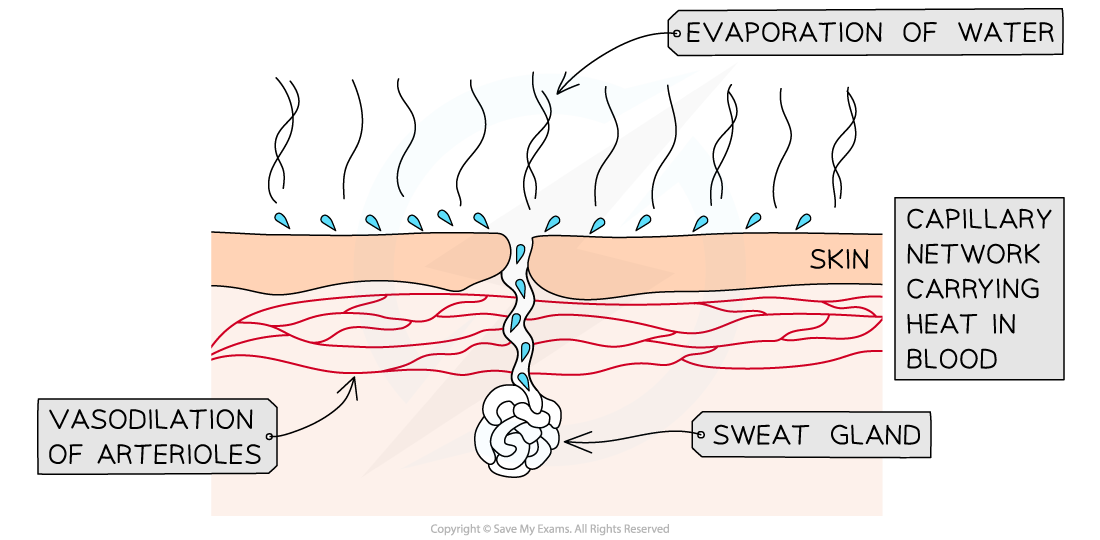- 翰林提供学术活动、国际课程、科研项目一站式留学背景提升服务!
- 400 888 0080
IB DP Biology: HL复习笔记2.1.4 Water
Properties of Water
NOS: Use theories to explain natural phenomena; the theory that hydrogen bonds form between water molecules explains the properties of water
- When scientists observe natural phenomena they try to come up with credible theories to explain their occurrence
- A theory is presumed to be correct if it explains the observation, is supported by experimental evidence and has not been falsified
- As hydrogen bonds are not visible, scientists can never say for certain that they exist, however there is strong experimental evidence to suggest that they do
- The presence and number of hydrogen bonds between polar water molecules helps to explain water's unique properties
The properties of water
Solvent
- As water is a polar molecule many ions (e.g. sodium chloride) and covalently bonded polar substances (e.g. glucose) will dissolve in it
- This allows chemical reactions to occur within the cytoplasm of cells (as the dissolved solutes are more chemically reactive when their individual molecules are free to move about)
- Metabolites can be transported efficiently (except non-polar molecules which are hydrophobic)
Water molecules 'surround' individual solute particles to ensure each solute particle is isolated from others
- This explains why solutions are clear - we can't see individual molecules that are separated from their crystal structures
This is also why concentrated solutions have a lower water potential or osmolarity
- Because many water particles are 'occupied' in keeping a solute molecule in solution, fewer water molecules are free to diffuse across partially permeable membranes
Water has a high specific heat capacity
- Specific heat capacity is a measure of the energy required to raise the temperature of 1 kg of a substance by 1oC
- Water has a high specific heat capacity of 4200 J/kg/oC meaning a relatively large amount of energy is required to raise its temperature
- The high specific heat capacity is due to the many hydrogen bonds present in water
- It takes a lot of thermal energy to break these bonds and a lot of energy to build them, thus the temperature of water does not fluctuate greatly
The advantage for living organisms is that it:
- Provides suitable, stable habitats
- Is able to maintain a constant temperature as water is able to absorb a lot of heat without wide temperature fluctuations
- This is vital in maintaining temperatures that are optimal for enzyme activity
Water in blood plasma is also essential in transferring heat around the body, helping to maintain a fairly constant temperature, especially at body extremities eg. fingertips
- As blood passes through more metabolically active (‘warmer’) regions of the body, heat energy is absorbed but the temperature remains fairly constant
- Water in tissue fluid also plays an important regulatory role in maintaining a constant body temperature
Water has a high latent heat of vaporisation
- In order to change state (from liquid to gas) a large amount of thermal energy must be absorbed by water to break the hydrogen bonds and allow individual gas particles to escape (evaporate)
- This explains water's high boiling point (100°C)
-
- Ice, liquid water and water vapour all play a vital role in the biosphere
- This is an advantage for living organisms as only a little water is required to evaporate for the organism to dissipate a great amount of heat
- This provides a cooling effect for living organisms, for example, the transpiration from leaves or evaporation of water in sweat from the skinWater is present on Earth in all three physical states (solid, liquid and gas) thanks to this characteristic
Properties of Water & its Role in Living Organisms Table
Cohesion and adhesion
- Hydrogen bonds between water molecules allows for strong cohesion between water molecules
- Allowing columns of water to move (called mass transport) through the xylem of plants and through blood vessels in animals
- Enabling surface tension where a body of water meets the air, these hydrogen bonds occur between the top layer of water molecules to create a sort of film on the body of water
- This layer is what allows insects such as pond skaters to move across the surface of water
Water is also able to hydrogen bond to other molecules, such as cellulose, which is known as adhesion
- This also enables water to move up the xylem during transpiration
- Cohesion and adhesion both contribute to water forming a meniscus in glassware, where water molecules adhere to polar molecules in the glass
- Water adheres to the xylem walls (made of lignin) by capillary action
Exam Tip
COhesion = water particles sticking to each otherADhesion = water particles sticking to other materials
Hydrophilic & Hydrophobic
- Biological molecules can be hydrophilic or hydrophobic (and sometimes both)
- Hydrophilic = "water-loving"
- Hydrophobic = "water-hating"
Polar molecules and molecules with positive or negative charges can form hydrogen bonds with water (and dissolve) so are generally hydrophilic
- Non-polar molecules with no positive or negative charge, cannot form hydrogen bonds with water so are generally hydrophobic
- These molecules tend to join together in groups due to hydrophobic interactions where hydrogen bonds form between water particles but not with the non-polar molecule
Because most biological molecules are hydrophilic and can be dissolved, water is regarded as the universal solvent
- Some large molecules have different groups with different characteristics
- Phospholipids have hydrophilic (phosphate group) heads and hydrophobic (hydrocarbon chain) tails. This dual character is a key feature in the structure and function of cell membranes

Due to its polarity water is considered a universal solvent
Focus on Water as a Coolant
- Water's high latent heat of vaporisation makes it an excellent coolant
- Animals have evolved sweating (perspiration) as a way of disposing of excess heat generated through physical activity
- The hypothalamus detects changes to blood temperature and when temperatures rise, it stimulates the secretion of sweat
- Small droplets of water are secreted from sweat glands onto the skin's surface
- Vasodilation of arterioles just beneath the skin carries more blood close to the surface
- Sweat (mainly water, also contains salts and other solutes) evaporates, carrying the excess heat away into the surrounding air and reducing the temperature of the organism
- Water's high latent heat of vaporisation allows only small volumes of water to be needed to carry away a lot of heat

The excess heat carried in blood causes the evaporation of sweat from the skin surface
Water as a coolant in plants
- Plants transpire
-
- A tree cannot seek shade, because it requires light energy for photosynthesis
- A tree is also immobile and provide shade for other organisms
- A transpiration stream of water flows up the tree, from roots to xylem to leaves, throughout the day
- Water evaporates inside the spongy mesophyll layer of leaves, so water vapour can diffuse out via the stomata
- For example, a large oak tree can absorb around 500 litres of water per day from the soil, around 90% of which is evaporated in transpiration to dissipate heat
- The remainder is used to keep cells turgid and as a raw material for photosynthesis
A large tree will stand in direct sunlight all day, so will absorb a huge amount of heat (as infra-red radiation from the Sun) on a hot day
Exam Tip
Sweat and transpiration have a lot of parallels in keeping animals and plants cool. This is why the French use the same word for both; the French word for "sweating" is "transpiration"!
Focus on Water as a Solvent
- Different solutes behave differently with water as a solvent
- Even though water is a universal solvent, different metabolites have different solubilities in water
- Different solutes have different hydrophobic and hydrophilic properties which affect their solubility in water
Highly soluble metabolites
- Some are highly soluble (eg. sodium chloride, urea), some are insoluble (eg. fats) and some have intermediate solubility (eg. oxygen and certain amino acids with a large R group)
-
-
- Even the amino acids with hydrophobic R groups are soluble enough to be freely transported in watereg. salts, glucose, amino acids
Highly soluble metabolites simply travel dissolved in the blood plasma
-
- Different transport mechanisms have evolved to assist in the transportation of the less soluble metabolites
Less soluble metabolites
- A low solubility metabolite such as oxygen requires assistance through combining with haemoglobin, to allow more oxygen to be carried than directly in blood plasma
- Oxygen is less soluble at body temperature (37ºC) than at 20ºC
- Oxygen is sparingly soluble but soluble enough to allow enough to dissolve in oceans, rivers and lakes for aquatic animals to breathe
- Haemoglobin can bind oxygen to allow sufficient oxygen to be transported to all body cells
Insoluble metabolites like fats require emulsification, and transport in lacteals, or by being converted to soluble phospholipids
- Cholesterol, which is insoluble, is converted to lipoproteins by combining with proteins
转载自savemyexams

最新发布
© 2025. All Rights Reserved. 沪ICP备2023009024号-1









